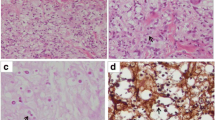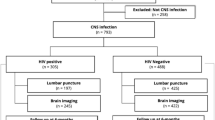Abstract
Cryptococcosis is a rare pediatric disease. The aim of the study is to describe clinical characteristics and prognosis of pediatric cryptococcosis from 2002 to 2014 in Beijing Children’s Hospital. A total of 53 cases of cryptococcosis were identified, 69.8% of which were males. The mean age was 7 years. Forty-one (77.4%) patients had no underlying conditions. Fever, headache, and vomiting were the most common symptoms. The most common sites were the central nervous system (CNS), followed by the lungs. Most patients received a combination of amphotericin B and fluconazole with or without flucytosine as their initial regimen. Twenty-seven patients received a follow-up and six patients (22.2%) had died. The factors associated with neurological complications or death were headache (P = 0.008), seizures (P = 0.006), visual impairment (P = 0.011), neck stiffness (P = 0.008), low erythrocyte sedimentation rate (ESR) (P = 0.024), and a cerebral spinal fluid (CSF) cryptococcal antigen titer ≥ 1:1024 (P = 0.038).
Conclusions: The majority of cryptococcosis cases in China occurred in children without underlying conditions, causing multiple organ damage. The CNS was the most common site. Patients who had headaches, seizures, or high CSF antigen titers experienced neurological complications or died.
What is known: • Cryptococcosis is a rare cause of infection in children. |
What is new: • This review gives a brief overview over pediatric cryptococcosis in China. |



Similar content being viewed by others
Abbreviations
- 5-FC:
-
5-Flucytosine
- AIDS:
-
Acquired immune deficiency syndrome
- AmB:
-
Amphotericin B deoxycholate
- CM:
-
Cryptococcal meningitis
- CNS:
-
Central nervous system
- CRP:
-
C-reactive protein
- CSF:
-
Cerebrospinal fluid
- ESR:
-
Erythrocyte sedimentation rate
- Flu:
-
Fluconazole
- HIV:
-
Human immunodeficiency virus
- MBL:
-
Mannose-binding lectin
- MRA:
-
Magnetic resonance angiography
- MRI:
-
Magnetic resonance imaging
- MRV:
-
Magnetic resonance venography
- VOR:
-
Voriconazole
- WBC:
-
White blood cell
- XLA:
-
X-linked agammaglobulinemia
References
Abadi J, Nachman S, Kressel AB, Pirofski L (1999) Cryptococcosis in children with AIDS. Clin Infect Dis 28(2):309–313. doi:10.1086/515130
Chaudhary MW, Sardana K, Kumar P, Dewan V, Anand VK (2005) Disseminated infection with Cryptococcus neoformans var neoformans in an 8 years immunocompetent girl. Indian J Pediatr 72(1):85
Chen J, Varma A, Diaz MR, Litvintseva AP, Wollenberg KK, Kwon-Chung KJ (2008) Cryptococcus neoformans strains and infection in apparently immunocompetent patients, China. Emerg Infect Dis 14(5):755–762. doi:10.3201/eid1405.071312
Choi YH, Ngamskulrungroj P, Varma A, Sionov E, Hwang SM, Carriconde F, Meyer W, Litvintseva AP, Lee WG, Shin JH et al (2010) Prevalence of the VNIc genotype of Cryptococcus neoformans in non-HIV-associated cryptococcosis in the Republic of Korea. FEMS Yeast Res 10(6):769–778. doi:10.1111/j.1567-1364.2010.00648.x
Dromer F, Mathoulin-Pélissier S, Launay O, Lortholary O (2007) French Cryptococcosis Study Group. Determinants of disease presentation and outcome during cryptococcosis: the CryptoA/D study. PLoS Med 4(2):e21. doi:10.1371/journal.pmed.0040021
Fan BJ, Wang BQ, Zhang HZ, He LX, Zhang ZY (2013) Analysis on clinical characteristics of pulmonary cryptococcosis under different immune status. Chin J Myco 8(4):193–197 (in Chinese)
Fang W, Fa Z, Liao W (2015) Epidemiology of Cryptococcus and cryptococcosis in China. Fungal Genet Biol 78:7–15. doi:10.1016/j.fgb.2014.10.017
Gibson JF, Johnston SA (2015) Immunity to Cryptococcus neoformans and C. gattii during cryptococcosis. Fungal Genet Biol 78:76–86. doi:10.1016/j.fgb.2014.11.006
Goldman DL, Khine H, Abadi J, Lindenberg DJ, La P, Niang R, Casadevall A (2001) Serologic evidence for Cryptococcus neoformans infection in early childhood. Pediatrics 107(5):E66
Gumbo T, Kadzirange G, Mielke J, Gangaidzo IT, Hakim JG (2002) Cryptococcus neoformans meningoencephalitis in African children with acquired immunodeficiency syndrome. Pediatr Infect Dis J 21(1):54–56
Guo J, Zhou J, Zhang S, Zhang X, Li J, Sun Y, Qi S (2012) A case-control study of risk factors for HIV-negative children with cryptococcal meningitis in Shi Jiazhuang, China. BMC Infect Dis 12:376. doi:10.1186/1471-2334-12-376
Guo LY, Liu LL, Liu Y, Chen TM, Li SY, Yang YH, Liu G (2016) Characteristics and outcomes of cryptococcal meningitis in HIV seronegative children in Beijing, China, 2002-2013. BMC Infect Dis 16(1):635
Hu XP, Wu JQ, Zhu LP, Wang X, Xu B, Wang RY, Ou XT, Weng XH (2012) Association of Fcγ receptor IIB polymorphism with cryptococcal meningitis in HIV-uninfected Chinese patients. PLoS One 7(8):e42439. doi:10.1371/journal.pone.0042439
Huang KY, Huang YC, Hung IJ, Lin TY (2010) Cryptococcosis in nonhuman immunodeficiency virus-infected children. Pediatr Neurol 42(4):267–270. doi:10.1016/j.pediatrneurol.2009.10.015
Jaın BB, Bose D, Mondal R, Chattopadhyay S (2014) Disseminated Cryptococcosis in an immunocompetent child. Turk Patoloji Derg. doi:10.5146/tjpath.2014.01230
Joshi NS, Fisher BT, Prasad PA, Zaoutis TE (2010) Epidemiology of cryptococcal infection in hospitalized children. Pediatr Infect Dis J 29(12):e91–e95. doi:10.1097/INF.0b013e3181fbc83d
Kidd SE, Hagen F, Tscharke RL, Huynh M, Bartlett KH, Fyfe M, Macdougall L, Boekhout T, Kwon-Chung KJ, Meyer W (2004) A rare genotype of Cryptococcus gattii caused the cryptococcosis outbreak on Vancouver Island (British Columbia Canada). Proc Natl Acad Sci 101:17258–17263. doi:10.1073/pnas.0402981101
Likasitwattanakul S, Poneprasert B, Sirisanthana V (2004) Cryptococcosis in HIV-infected children. Southeast Asian J Trop Med Public Health 35(4):935–939
Liu K, Ding H, Xu B, You R, Xing Z, Chen J, Lin Q, Qu J (2016) Clinical analysis of non-AIDS patients pathologically diagnosed with pulmonary cryptococcosis. J Thorac Dis 8(10):2813–2821. doi:10.21037/jtd.2016.10.36
Lizarazo J, Escandón P, Agudelo CI, Castañeda E (2014) Cryptococcosis in Colombian children and literature review. Mem Inst Oswaldo Cruz 109(6):797–804
Luo FL, Tao YH, Wang YM, Li H (2015) Clinical study of 23 pediatric patients with cryptococcosis. Eur Rev Med Pharmacol Sci 19(20):3801–3810
Meiring ST, Quan VC, Cohen C, Dawood H, Karstaedt AS, McCarthy KM, Whitelaw AC (2012) Govender NP; Group for Enteric, respiratory and meningeal disease surveillance in South Africa (GERMS-SA). A comparison of cases of paediatric-onset and adult-onset cryptococcosis detected through population-based surveillance, 2005-2007. AIDS 26(18):2307–2314. doi:10.1097/QAD.0b013e3283570567
Meyer W, Castañeda A, Jackson S, Huynh M, Castañeda E (2003) Molecular typing of IberoAmerican Cryptococcus neoformans isolates. Emerg Infect Dis 9(2):189–195. doi:10.3201/eid0902.020246
Miglia KJ, Govender NP, Rossouw J, Meiring S (2011) Mitchell TG; Group for Enteric, respiratory and meningeal disease surveillance in South Africa. Analyses of pediatric isolates of Cryptococcus neoformans from South Africa. J Clin Microbiol 49(1):307–314. doi:10.1128/JCM.01277-10
Mullan PC, Steenhoff AP, Draper H, Wedin T, Bafana M, Anabwani G, Jibril H, Tshepo M, Schutze GE (2011) Etiology of meningitis among patients admitted to a tertiary referral hospital in Botswana. Pediatr Infect Dis J 30(7):620–622. doi:10.1097/INF.0b013e318210b51e
Murphy SN, Parnell N (2005) Fluconazole treatment of cryptococcal rib osteomyelitis in an HIV-negative man. A case report and review of the literature. J Inf Secur 51(5):e309–e311. doi:10.1016/j.jinf.2005.02.028
Natukunda E, Musiime V, Ssali F, Kizito H, Kityo C, Mugyenyi P (2011) A case of Cryptococcal lymphadenitis in an HIV-infected child. AIDS Res Hum Retrovir 27(4):373–376. doi:10.1089/aid.2010.0167
Ou XT, Wu JQ, Zhu LP, Guan M, Xu B, Hu XP, Wang X, Weng XH (2011) Genotypes coding for mannose-binding lectin deficiency correlated with cryptococcal meningitis in HIV-uninfected Chinese patients. J Infect Dis 203(11):1686–1691. doi:10.1093/infdis/jir152
Pappas PG, Perfect JR, Cloud GA, Larsen RA, Pankey GA, Lancaster DJ, Henderson H, Kauffman CA, Haas DW, Saccente M et al (2001) Cryptococcosis in human immunodeficiency virus-negative patients in the era of effective azole therapy. Clin Infect Dis 33(5):690–699. doi:10.1086/322597
Park BJ, Wannemuehler KA, Marston BJ, Govender N, Pappas PG, Chiller TM (2009) Estimation of the current global burden of cryptococcal meningitis among persons living with HIV/AIDS. AIDS 23(4):525–530. doi:10.1097/QAD.0b013e328322ffac
Perfect JR, Dismukes WE, Dromer F, Goldman DL, Graybill JR, Hamill RJ, Harrison TS, Larsen RA, Lortholary O, Nguyen MH et al (2010) Clinical practice guidelines for the management of cryptococcal disease: 2010 update by the infectious diseases society of america. Clin Infect Dis 50(3):291–322. doi:10.1086/649858
Pyrgos V, Seitz AE, Steiner CA, Prevots DR, Williamson PR (2013) Epidemiology of cryptococcal meningitis in the US: 1997-2009. PLoS One 8(2):e56269. doi:10.1371/journal.pone.0056269
Randhawa HS, Kowshik T, Chowdhary A, Prakash A, Khan ZU, Xu J (2011) Seasonal variations in the prevalence of Cryptococcus neoformans var. grubii and Cryptococcus gattii in decayed wood inside trunk hollows of diverse tree species in north-western India: a retrospective study. Med Mycol 49(3):320–323. doi:10.3109/13693786.2010.516457
Severo CB, Xavier MO, Gazzoni AF, Severo LC (2009) Cryptococcosis in children. Paediatr Respir Rev 10(4):166–171. doi:10.1016/j.prrv.2009.06.009
Yamaguchi H, Komase Y, Ikehara M, Yamamoto T, Shinagawa T (2008) Disseminated cryptococcal infection with eosinophilia in a healthy person. J Infect Chemother, 2008 14(4, Aug 17):319–324. doi:10.1007/s10156-008-0618-z.Epub
Yuanjie Z, Jianghan C, Nan X, Xiaojun W, Hai W, Wanqing L, Julin G (2012) Cryptococcal meningitis in immunocompetent children. Mycoses 55(2):168–171. doi:10.1111/j.1439-0507.2011.02063.x
Zhang C, Du L, Cai W, Wu Y, Lv F (2014) Isolated hepatobiliary cryptococcosis manifesting as obstructive jaundice in an immunocompetent child: case report and review of the literature. Eur J Pediatr 173(12):1569–1572. doi:10.1007/s00431-013-2132-2
Zhu LP, Wu JQ, Xu B, Ou XT, Zhang QQ, Weng XH (2010) Cryptococcal meningitis in non-HIV-infected patients in a Chinese tertiary care hospital, 1997–2007. Med Mycol 48:570–579. doi:10.3109/13693780903437876
Acknowledgements
We thank Dr. Mobeen Rathore for his valuable suggestions and critical review of this manuscript.
Author information
Authors and Affiliations
Contributions
All of the authors had access to the full dataset (including the statistical reportsand tables) and take responsibility for the integrity of the data and the accuracy of the data analysis. Gang Liu, Yonghong Yang, Lingyun Guo, Linlin Liu, Yue Liu and Shaoying Li conceived and designed thestudy. Gang Liu, Lingyun Guo, Linlin Liu, Yue Liu and Tianming Chen collected the data and designed the analysis. Gang Liu, Yonghong Yang, Lingyun Guo, Linlin Liu and Yue Liu interpreted the data. Lingyun Guo and Linlin Liu wrote the first draft of the paper. Gang Liu, Lingyun Guo and Linlin Liu reviewed and approved the final report.
Corresponding author
Ethics declarations
Funds
This work was supported by the Beijing Municipal Administration of Hospitals Incubating Program (No. PX2016035) and the Beijing Health System Top Level Health Technical Personnel Training Plan (No. 2015-3-082).
Conflict of interest
The authors declare that they have no conflict of interest.
Ethical approval and informed consent
This study was reviewed and approved by the Ethics Committee of Beijing Children’s Hospital Affiliated to Capital Medical University (2017-k-26). Because this is a retrospectively study, we obtained the data of patients from the Medical Records and Statistics Room and we analyzed the data anonymously; thus, informed consent was not required.
Additional information
Communicated by Nicole Ritz
Rights and permissions
About this article
Cite this article
Liu, L., Guo, L., Liu, Y. et al. Clinical characteristics and prognosis of pediatric cryptococcosis in Beijing Children’s Hospital, 2002–2014. Eur J Pediatr 176, 1235–1244 (2017). https://doi.org/10.1007/s00431-017-2974-0
Received:
Revised:
Accepted:
Published:
Issue Date:
DOI: https://doi.org/10.1007/s00431-017-2974-0




